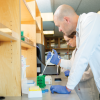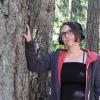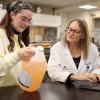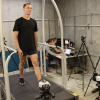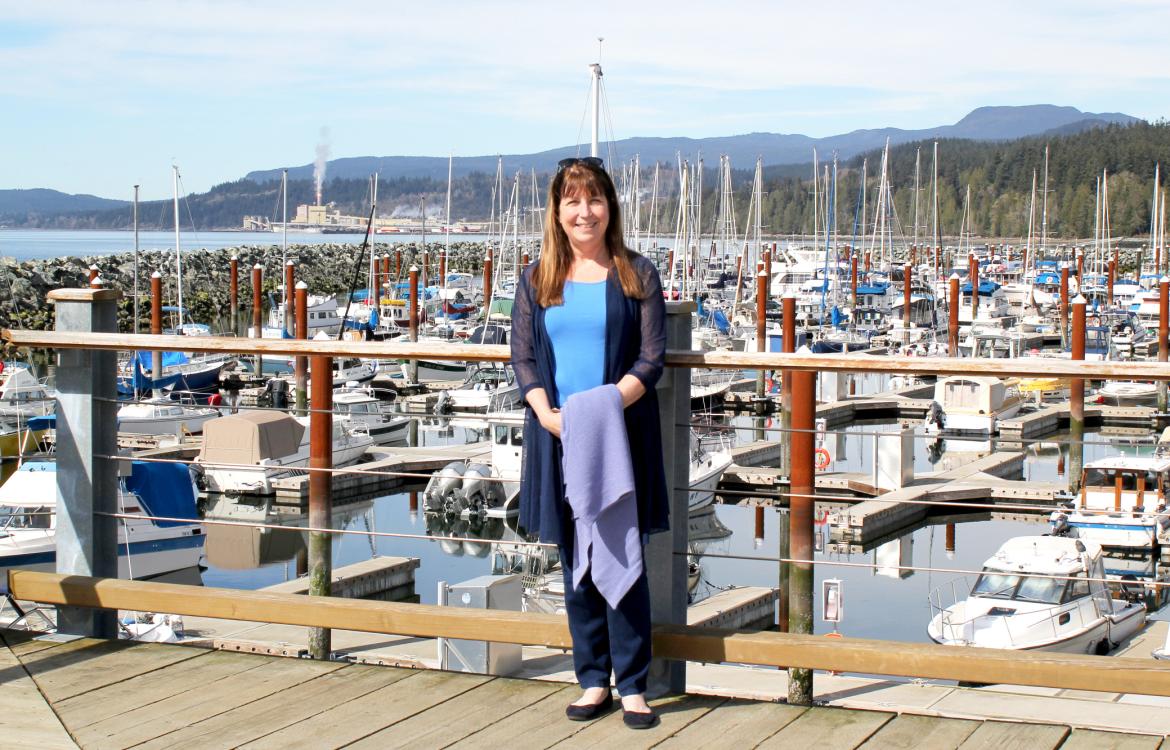
Alison Taplay enjoys a sunny day at the Powell River boat harbour. The mill that helped define the town is pictured behind her.
April 6, 2016 - 1:15pm
Defining Diversity, Creating Community helps shape future of Powell River
After four years a citizen engagement research project undertaken in Powell River, B.C. is complete. The final report is available and according to project coordinator Alison Taplay, even though the Defining Diversity, Creating Community (DDCC) project is done she expects the effects will continue to reverberate through the small, Oceanside community for a long time to come.
Taplay, who teaches at Vancouver Island University’s (VIU) Powell River Campus, presented in Nanaimo at VIU’s Research and Scholarly Activity Office weekly Lunch and Learn. Her talk, Illuminating New Economic Possibilities Through Community Engaged Research – The Case of Powell River, was an overview of DDCC.
To understand why DDCC was launched, Taplay says one must understand the history of the region the research was conducted in.
“Founded in 1910 as a company town site, Powell River was once home to the world’s largest pulp mill. At its peak it employed thousands of people. Gradually though, production dropped and so did the number of workers. It still operates today, but with a workforce of only around 300,” said Taplay.
“The landscape was quite polarized around the transition away from the mill. As the years passed the town suffered large layoff after large layoff. Amongst all of this change people had ideas about what should happen and what direction Powell River should go in. Often, those ideas were very different.”
Taplay says in the early years hundreds of newcomers came to Powell River from places like Italy, Ireland and Germany to work at the mill and despite the layoffs, many stayed.
“It is a diverse place, in part, because of this and it is on this backdrop that DDCC was launched,” said Taplay.
In 2010, a documentary film called Defining Diversity, Creating Community was produced in Powell River that brought many issues related to diversity to the surface. Because of its success VIU was approached to turn the theme of the documentary into a two day course to continue to explore the issues it touched on. Created by professor and community volunteer Janet Newbury, in consultation with Taplay, a pilot course was created and offered to community members for no charge. The success of that course was the seed that the four year research project grew from.
DDCC expanded to include workshops and focus groups that culminated in a conference called Groundswell that had almost 200 participants. Taplay says the project couldn’t have been successful without the support of the local Tla’amin First Nation. Tla’amin Elders and leaders led the conference and were involved in DDCC from the beginning.
“Thanks to the Tla’amin’s extensive and authentic participation, the tone and the culture of all the projects were set. Elders were interviewed about the town and about the things that were and weren’t changing,” said Taplay.
“Tla’amin Elder Dr. Elsie Paul and Elder in Residence Eugene Louie were involved throughout. They brought so much leadership, wisdom and mentorship to the process. Perhaps, most importantly, they showed participants that things didn’t have to be just one way.”
Another initiative that was launched had 11 local business people interviewed to give voice to the economic sector. Seven articles from those interviews were published in Powell River Living Magazine.
Taplay says over time DDCC became more than a research project – it created relationships among community members from very different backgrounds and brought a deeper understanding about the value of diversity, the effects of discrimination and it envisioned new approaches to asset-based community development that were inclusive, not exclusionary.
“Asset-based community development is about demonstrating that each person in a community, regardless of their role, has a gift or contribution that when embraced and valued helps a community to thrive,” said Taplay.
“Through the DDCC process community members found they shared a lot of the same fears, hopes and dreams for their community. We knew, as educators, that what we were seeing was incredibly valuable.”
She says the effects of bringing people together in a safe space to discuss issues is not something that brings huge changes quickly. Change is happening in Powell River and according to Taplay, it is emerging as a result of many small actions by multiple players.
Taplay cites the Powell River city council as an example. She says it isn’t strictly right leaning or left leaning in the way it governs, which is how it always was in the past. The council that was elected since the DDCC work began, says Taplay, is more diverse, collaborative, engaged with citizens, and addresses community development more effectively.
“That is a temperature gauge to how things are hopefully going to be moving forward. I think overall a number of small acts, our research project being one of them, are creating a new communications paradigm that we can build on,” said Taplay.
“I think our research has precipitated a shift where people are more willing to work across divides and out of their usual silos. The people of Powell River can see the importance of working with people who are doing different things in different ways and that has huge implications for the future of community.”
To learn more about the DDCC project and to read their final report, go to: http://wordpress.viu.ca/ddcc/
-30-
Tags: Research

